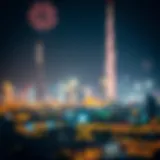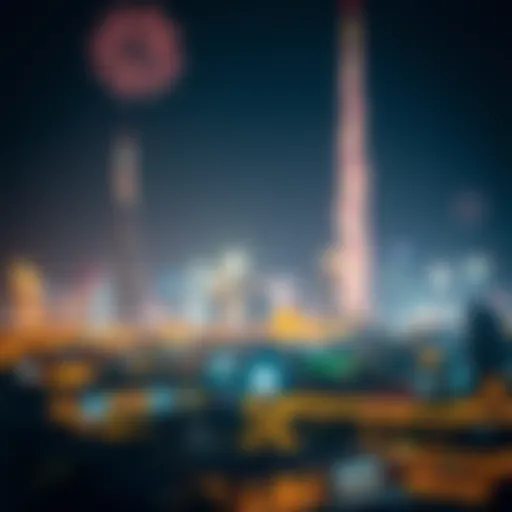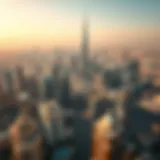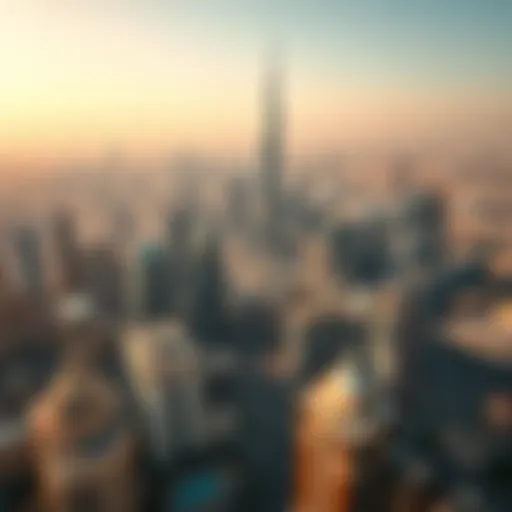The Historical Importance of the Old Dubai Market
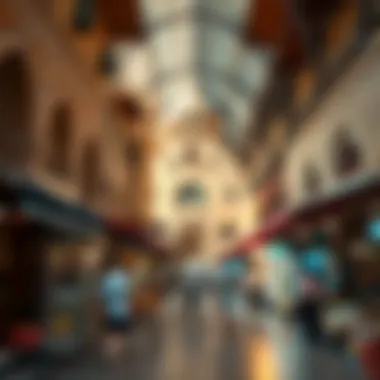
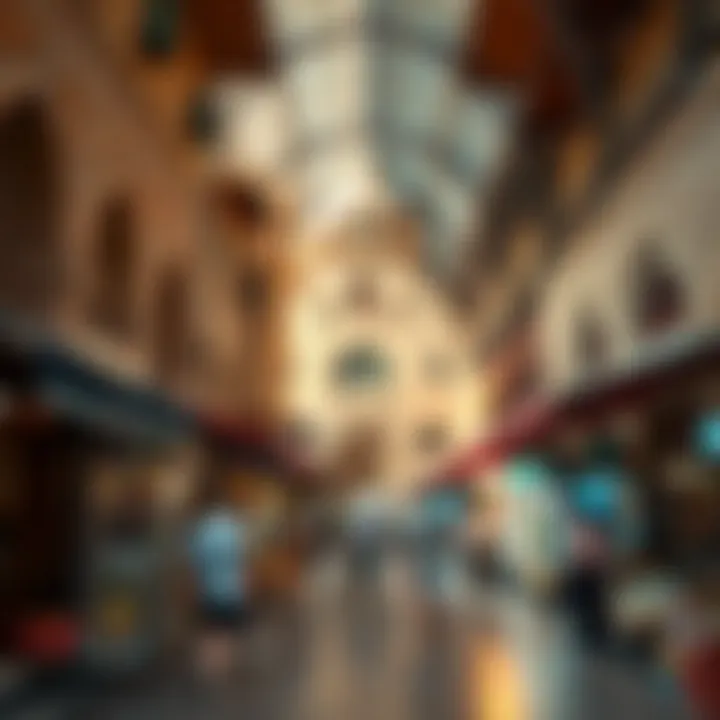
Intro
Situated along the banks of Dubai Creek, the Old Dubai Market, or 'سوق بر دبي القديم,' is not just a maze of alleys bursting with the fragrances of spices and textiles but also a potent symbol of the city's dynamic past. Through the ages, it has witnessed the ebb and flow of trade, reflecting the fusion of cultures, commerce, and community. The market stands as a living testament to the historical tapestry of Dubai, mapping its metamorphosis from a quiet fishing village into a vibrant global hub.
The attractiveness of the Old Dubai Market extends beyond its mere physicality; it is interwoven into the very economic fabric of Dubai. The myriad of shops, from traditional gold souks to shops selling intricate handicrafts, encapsulates the essence of Dubai's rich heritage. This article seeks to shine a spotlight on the intricacies of the Old Market's architecture, the cultural significance of its offerings, and its impact on the local economy.
Moreover, it provides a view into the real estate dynamics that surround this historical site. Navigating through current pricing trends captures not just the market's pulse but also its expectations for the future. These insights can guide investors, individuals looking to buy property, and those fascinated by the architectural splendor that has stood against the tide of rapid development.
As we delve deeper into this exploration, the article promises to enrich your understanding of how the Old Dubai Market continues to thrive amid an ever-changing urban landscape.
Prelude to the Old Dubai Market
The Old Dubai Market, known as "سوق بر دبي القديم," serves as more than just a shopping destination; it is a vivid tapestry woven into the fabric of Dubai’s cultural and historical identity. As one strolls through its narrow alleys and bustling stalls, one can sense the rhythm of a world that echoes with the tales of generations. This section delves into the essence of the Old Dubai Market and why it holds a prominent place in the narrative of Dubai's past and future.
To start, the Old Dubai Market is fundamentally significant as it encapsulates the spirit of trade that spurred the region’s growth. Before the skyscrapers and luxury malls emerged, the market stood as a hub where merchants from various backgrounds convened to exchange not only goods but stories and cultures. The market's vibrancy and diversity have fostered a sense of community that is hard to replicate in today’s fast-paced world.
Key Elements and Benefits
Talking about its environment, the market is set against the backdrop of traditional architecture, showing how the old world meets modernity. The architectural styles here reflect a rich history shaped by various influences, from Persian to Indian to Bedouin cultures. Here are some critical elements worth noting:
- Historical Significance: It ties back to ancient trade routes which facilitated the movement of goods and cultural exchanges.
- Cultural Essence: Renowned for its crafts, spices, and textiles, it symbolizes Dubai's multicultural personality.
- Economic Role: The old market played a significant role in shaping the local economy, paving the way for the contemporary real estate landscape we see today.
Moreover, the Old Dubai Market isn’t just about shopping; it’s about experiences and interactions. Visitors often find themselves enchanted by local artisans showcasing their crafts, and the aroma of spices fills the air, creating a sensory experience that’s unparalleled. It's a place where history, culture, and commerce intertwine, providing deep insights into the region’s evolving identity.
In exploring the Old Dubai Market, one encounters not only consumerism but also the story of a city that has transformed over decades while retaining its roots. This article aims to uncover the layers behind its existence, examining its historical context, architectural features, cultural significance, and the economic impact it has exerted over time.
"The Old Dubai Market is a mirror reflecting both ancient traditions and modern aspirations, illustrating how history continues to influence the present."
In essence, this introduction sets the stage for a comprehensive exploration of the Old Dubai Market. Understanding its past is essential, as it allows investors, designers, and analysts to grasp the significance of what this market represents in today’s rapidly changing landscape. Every transaction, every craft, and every interaction here is part of a larger story—one that is both fascinating and vital to comprehend as we look towards the future.
Historical Context
Understanding the historical context of the Old Dubai Market is crucial for grasping its enduring significance. This marketplace, which has been a centerpiece of Dubai for centuries, reflects the rich tapestry of trade, culture, and architecture that defines the city. Its origins trace back to a time when Dubai was primarily a fishing village and a modest trading port. The market has not only served as a commercial hub but has also been a stage for various social interactions, highlighting its importance beyond mere economic transactions.
The Old Dubai Market stands as a testament to the resilience and adaptability of the region. It provides a direct link to the pre-oil era of Dubai, showcasing how the city transitioned from a humble community to a modern metropolis. When exploring this historical context, it’s essential to consider the various elements that contributed to the market's significance. Those include the rise of maritime trade routes, the migration of different cultures which enriched the local social fabric, and the architectural styles that emerged in response to these interactions.
Moreover, the Old Dubai Market offers investors and analysts a window into the socio-economic transformations that have shaped Dubai. A thorough understanding of its past helps highlight the importance of preserving such cultural landmarks amid rapid modernization. As the landscape of the city evolves, the market’s legacy serves as a reminder of the historical basis of Dubai’s current economic prosperity.
Origins of the Market
The roots of the Old Dubai Market can be traced back to the early 20th century, where it initially developed from the informal trading activities that were commonplace along Dubai Creek. This stretch of water was not just a scenic view; it was a bustling trade route where merchants from surrounding regions converged to exchange goods. From textiles and spices to pearls and dates, the creek acted as the lifeblood of early commerce, paving the way for the establishment of the market.
The first informal stalls grew around the creek as local traders began to gather, bringing with them diverse cultural influences. It was a melting pot of activity, and over time these informal arrangements organically evolved into the structured market we see today. Not only did it serve local needs, but it quickly became a vital point for regional trade, drawing merchants from as far away as India and Persia.
"The essence of the Old Dubai Market embodies not just commerce but the cultural negotiations of its time."
The social interactions that occurred here facilitated the sharing of traditions, languages, and cuisines, fostering a unique identity that is now synonymous with Dubai. Even today, while visiting, one can notice the almost hypnotic interplay of scents, sounds, and languages, which all hark back to its rich history.
Growth Through Trade Routes
As Dubai’s trade networks expanded, so did the market’s prominence. The strategic location of Dubai along vital maritime routes contributed significantly to the boom of the Old Dubai Market. Thanks to the deep waters of Dubai Creek, larger ships began docking, allowing for trade with distant lands. These connections brought not only goods but also an influx of diverse populations who settled in the area.
In the 1950s, as oil was discovered, this once humble marketplace gradually adapted to the changing economic landscape. The growth of the petroleum industry brought about modernization, but the market retained its relevance. Its ability to adapt to new economic realities is a testament to the traders’ resilience and creativity.
Some critical aspects of growth include:
- Increased Trade: The influx of goods from distant locations enriched local markets and allowed residents access to a trove of products that were previously foreign to them.
- Cultural Exchange: With the arrival of different nationalities, ideas and customs blended, which nowadays can be seen in the culinary varieties and traditional crafts that populate the market.
- Economic Solidarity: The strong sense of community and mutual support found in this marketplace helped boost local economies, with many families relying on trade for their income.
Today, the Old Dubai Market continues to be an essential part of the city's economic landscape and a vibrant center for cultural exchange. The historical layers present in this market are a critical aspect of Dubai's identity, with all eyes on how such heritage will endure amid rapid changes.
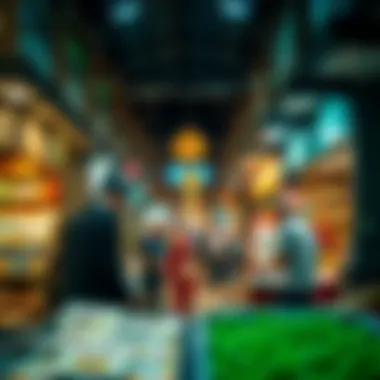
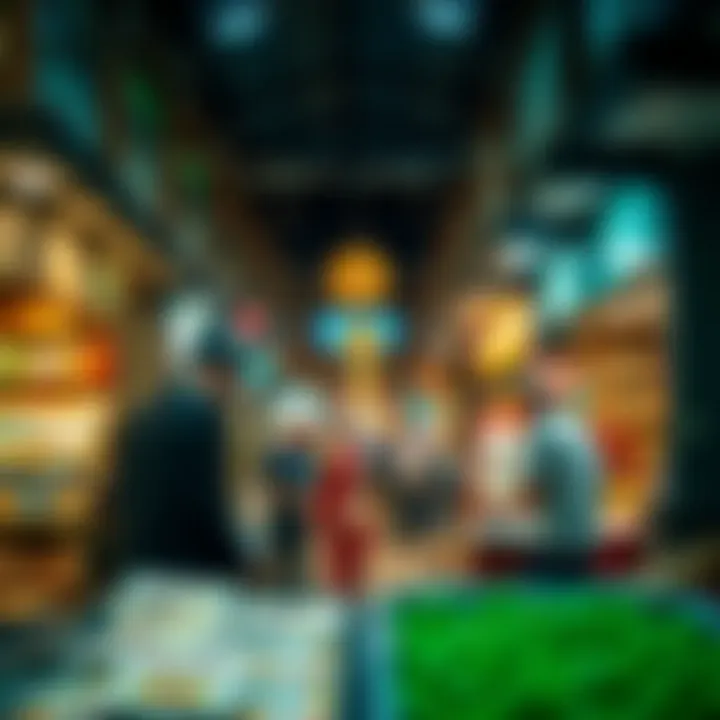
Architectural Features
The Old Dubai Market serves as a remarkable pillar of the city’s heritage, not only through its bustling trade but also via its architectural nuances that whisper tales of yesteryears. Understanding the architectural features of the Old Dubai Market enhances comprehension of its grandeur and significance today. By meticulously weaving traditional design elements with contemporary necessities, the market reflects an enduring legacy and cultural identity. Such architectural elements also delineate the market’s adaptability in the face of rapid urbanization.
Traditional Design Elements
The essence of the Old Dubai Market's architecture can be traced back to traditional design elements that evoke a sense of nostalgia and pride among locals. The distinctive wind towers, known as “barjeel,” grace the skyline, guiding cool breezes into shops while mitigating the relentless heat. This feature not only served a practical function but also symbolizes the ingenuity of Emirati architecture, blending comfort with aesthetics. Moreover, the intricate wooden latticework and mashrabiya—a wooden protruding balcony—are prime examples of how form meets function. These elements reflect the craftsmanship and artistry of the time, with local artisans meticulously carving designs that often told stories or conveyed cultural significance.
The marketplace itself is laid out in a maze-like manner, fostering an environment that encourages exploration and social interaction. A visit through the narrow alleyways hand-in-hand with the bustling ambiance evokes a sense of community that transcends mere commercial transactions. Visitors encounter a richness in diversity, from spice traders to textile vendors, each stall a living reminder of Dubai's mercantile past.
Conservation of Heritage
In recent years, conservation of heritage has taken center stage in discussions surrounding the Old Dubai Market. As the city burgeons into a modern metropolis, the challenge lies in preserving the market's historical fabric while catering to contemporary needs. Initiatives have been launched to restore and protect the market's original structures, illustrating a commitment to safeguarding its historical significance. This includes maintaining the authenticity of building materials and traditional construction techniques, which, in turn, instills a sense of pride among residents and investors alike.
Importantly, conservation efforts aim to balance the old with the new. While renovations might bring in modern facilities, they do so without undermining the traditional charm of the market. Emphasizing sustainability in these endeavors recognizes the task of intertwining heritage and innovation. One notable effort can be observed in the restoration of the Al Fahidi Historical Neighbourhood, a project that underscores Dubai’s commitment to preserving its past whilst progressing towards the future.
The Old Dubai Market stands not only as a commercial hub but as a compelling canvas showcasing architectural brilliance and a vigorous cultural heartbeat. As the market continues to evolve, preserving its architectural features is crucial in upholding the identity and richness of Dubai’s heritage.
Cultural Significance
The Old Dubai Market, often referred to as 'سوق بر دبي القديم,' serves as more than just a venue for trade; it is the lifeblood of the community, a palette splashed with rich colors of tradition and modernity woven together. This narrative is not simply about commerce; it circles around the identity and heritage of Dubai itself. In a landscape rapidly changing, the market stands resilient, embodying the essence of cultural continuity amid burgeoning skyscrapers and glitzy malls.
Role in Community Life
The market has been a focal point of the local populace for generations, a gathering place where friendships blossom amidst the clamor of bargaining voices and the aromas of spices fill the air. For many, it’s not just about the transactions; it’s about connection.
In many ways, the market mirrors the heartbeat of Dubai's diverse society, where various communities converge. Here, you find local artisans showcasing their crafts and traders sharing tales of their ancestors and their ties to the region. The ethos of hospitality is palpable, as vendors invite passersby to sample their wares, be it fragrant saffron or handmade textiles. Visitors often leave with not just goods, but memories of shared laughter and genuine conversations.
- Local interactions: The market is a stage for social interactions. It fosters relationships among residents, sellers, and buyers alike.
- Youth engagement: Young people find opportunities to connect with their cultural roots, learning traditional trades or partaking in community initiatives.
- Representing diversity: The market brings together Arab, South Asian, and many other cultures, making it a melting pot of global influences, showcasing Dubai's status as a bridge between East and West.
This blend of interaction fosters a deep pride among locals, as they witness a place where tradition and modernity coalesce peacefully.
Cultural Events and Festivals
Throughout the year, the Old Dubai Market transforms into a cultural hub, hosting events and festivals that bring the community together in celebration. These occasions serve not only to promote the market but also as a reminder of the importance of cultural heritage.
During the Ramadan month, the market is alive with the spirit of community as it hosts Iftar events, where families gather to break their fast together. This emphasizes the concept of unity and sharing, deeply rooted in Emirati culture. Similarly, local artisans often showcase their crafts during Dubai Shopping Festival and National Day celebrations, highlighting the market’s role in preserving traditional skills.
The vibrancy of these events can be best appreciated through the following:
- Live performances: Musicians and dancers often take to informal stages, enchanting the crowd and enhancing the festive atmosphere, resonating with the cultural heritage.
- Interactive stalls: Each festival brings unique opportunities for visitors to engage with crafts, from pottery to weaving demonstrations, immersing themselves in local traditions.
- Food festivals: Culinary events feature traditional dishes that speak to the region's history and community family recipes.
"In its heart, the Old Dubai Market is a testament to how culture intermingles with everyday lives, forming a unique social fabric that both reflects and shapes the identity of its people.”
In essence, the cultural significance of the Old Dubai Market is irrefutable. The market is not merely an economic entity; it is a dynamic cultural landscape that embodies the traditions, narratives, and relationships that define the community’s spirit. Through its role in community life and the celebration of cultural events, the market reveals itself as a historical thread that stitches together the past, present, and future of Dubai.
Economic Impact
The Old Dubai Market serves as a critical player in the broader economic landscape of Dubai, shaping both local and regional commerce. Its historical roots and ongoing relevance illustrate how markets can transcend mere trade, embodying the spirit of a community's economic identity. Understanding the economic impact of this market demands a closer look at various factors that contribute to its significance, including market dynamics, job creation, and sustainability initiatives.
Market Dynamics
In the bustling heart of Dubai, the Old Dubai Market operates as a microcosm of global trade dynamics. With a mix of both local and international vendors, it showcases products that reflect both cultural heritage and modern innovation. The interactions within the market stimulate price competition and continuous product improvement. When merchants from different backgrounds converge, they create a lively atmosphere of trade where bargaining often resembles an art form, pulling in both seasoned shoppers and the curious tourist.
- Variety of Goods: From spices to textiles, and traditional handicrafts to modern trinkets, the market is a mosaic of offerings. This variety caters to different tastes and preferences, making it a go-to destination for diverse shoppers.
- Seasonal Trends: Different times of the year see varied demand in commodities, influenced by festivals and holidays. For example, during Ramadan, one might observe a noticeable uptick in the sale of dates and other traditional items, reflecting the local culture’s influence on buying patterns.
The shift in consumer behavior towards digital platforms has also recently affected market dynamics. More vendors are embracing online sales, which provokes a response from traditional establishments. This evolution invites a discussion about whether online shopping dulls the vibrant experience of physical markets or offers vendors a necessary lifeline in a changing economy.
Jobs and Livelihoods
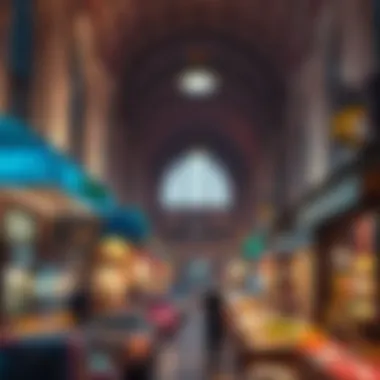
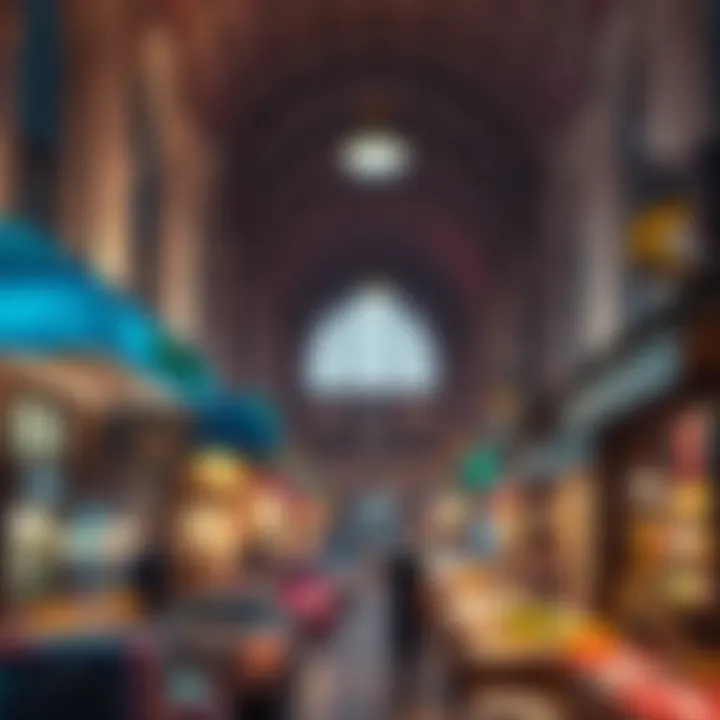
The Old Dubai Market does not just boost the economy numerically; it plays a crucial role in sustaining the livelihoods of many individuals and families. Jobs created here extend far beyond retail positions. A web of opportunities links various stakeholders together, including artisans, importers, and service providers.
In the market, you'll find:
- Artisan Craftsmanship: Local artisans contribute to the market’s charm, offering handmade goods that are hard to find elsewhere. Their skills not only preserve cultural traditions but also create niche markets that attract discerning buyers.
- Employment Opportunities: Countless jobs exist across the spectrum of roles within the market, from shopkeepers to workers in logistics and supply chain management. Vendors are often small family businesses, promoting a cycle of entrepreneurship that fosters community resilience.
- Support for Education: Money earned by families working in the market often goes towards children's education, allowing the next generation to benefit from better opportunities and contributing to the area's overall progress.
"In vibrant communities, markets stand as pillars of both culture and economy, nurturing not just commerce but also camaraderie."
Moreover, the Old Dubai Market reflects the broader trend of urban employment. As old trade practices and modern skills blend, the labor dynamics within the market signal adaptability—treading the line between tradition and progression.
Understanding these economic impacts provides valuable insights for investors, buyers, and designers looking to harness the spirit of this iconic market while being mindful of its fundamental economic roles. Thus, the Old Dubai Market stands not just as a historical site but as a continuing stakeholder in Dubai's economic narrative.
Visitor Experiences
The Old Dubai Market, known colloquially for its immersive atmosphere, plays a significant role in attracting both tourists and locals alike. The array of experiences offered here encapsulates a vivid narrative about the region’s rich past and evolving cultural landscape. Visitors do not just come to shop; they engage in a sensory pilgrimage that ranges from browsing vibrant local crafts to indulging in the tantalizing fusion of flavors that characterize Dubai's culinary scene. This section highlights its importance as a microcosm of Dubai’s heritage, which stands testament to both tradition and modernity.
Shopping and Local Crafts
The market's unique charm lies in its maze-like layout, where narrow alleys beckon with rows of artisanal shops. Here, vendors proudly display their wares, from handwoven textiles to intricate silver jewelry. Each item carries a story, embodying the craftsmanship passed down through generations. Visitors often find treasures that reflect the allure of Dubai's culture and traditions.
- Authenticity: Shoppers are drawn to the idea of purchasing locally crafted goods, contributing to the sustainability of traditional practices.
- Experience: Interacting with artisans allows visitors to understand the meticulous processes behind each piece. It’s common for a visitor to leave with not just a purchase, but a newfound appreciation for the skill involved.
- Cultural Exchange: In these interactions, buyers from around the world partake in cultural dialogues that enrich their understanding of Middle Eastern heritage.
“Experiencing the Old Dubai Market is about more than shopping; it’s about connecting with the pulse of the city’s legacy.”
Local crafts in the Old Dubai Market often employ techniques that are centuries old, making each visit an educational journey. Visitors become part of a living history, ensuring that skills and traditions are preserved in an ever-changing market landscape.
Culinary Adventures
The culinary scene within this market is an attraction in its own right. As visitors wander through the bustling lanes, they are enveloped in enticing aromas, tantalizing taste buds and luring them toward small, authentic eateries. The eateries offer shawarma, hummus, and a myriad of spices that sing tales of the region’s diverse culture. Each bite becomes a lesson in flavors that paint a picture of Dubai's multicultural tapestry.
- Street Food: The market serves exemplary street food experiences. An unpretentious shawarma stall can turn into a dining highlight, demonstrating how humble dishes can delight the senses.
- Diverse Flavors: The blend of Middle Eastern, Indian, and North African cuisines brings together flavors that reflect the myriad of cultures present in Dubai.
- Cooking Classes: Some establishments offer cooking classes where visitors can learn to prepare traditional dishes, cultivating a deeper connection to the local culture.
Visiting the market allows tourists to indulge in an epicurean adventure, making food a bridge between cultures. Each meal serves not only as nourishment but also as a significant exploration of tradition, blending the old with the contemporary.
In summary, the visitor experience at the Old Dubai Market is multifaceted. It invites people to shop for authentic crafts and immerse themselves in a culinary tour that fuses history and modern-day life. Every corner of the market pulsates with life, reflecting a community deeply rooted in tradition yet adaptable to the currents of change. The interactions, flavors, and items found here will leave a lasting imprint on anyone keen to understand the essence of Dubai.
Comparative Analysis
The significance of Comparative Analysis within the context of the Old Dubai Market cannot be overstated. This section aims to contextualize the historical market against the backdrop of contemporary trading spaces, providing a fine-tooth comb examination of elements that define the market landscape today. Through comparing traditional markets like the Old Dubai Market with modern commercial entities, we can unveil critical insights regarding consumer behavior, economic trends, and architectural evolution.
Modern Markets vs. Traditional Ones
In today's fast-paced economic climate, modern markets have popped up like mushrooms after a rainstorm, boasting high-tech facilities and a slew of conveniences. However, they often lack the soul and stories embedded in traditional markets such as the Old Dubai Market. Here are a few key points of comparison:
- Atmosphere: Traditional markets usually exude a vibrant soul, replete with the sounds of bartering and the fragrance of spices, creating an immersive experience. Modern setups, in contrast, often feel sterile, offering a uniform shopping experience driven by efficiency over heritage.
- Product Offerings: The Old Dubai Market is a veritable treasure trove of local crafts, spices, and textiles that tell tales of Dubai's mercantile past. Newer markets often prioritize branding over substance, leading to a one-size-fits-all approach that can dilute unique cultural expressions.
- Customer Engagement: Shopping in the Old Dubai Market is not just about acquiring goods; it’s a social affair where interactions hold equal weight to transactions. In contrast, modern markets frequently rely on digital interactions, steering away from face-to-face connections.
- Economic Dynamics: While modern markets cater to mass production and international brand dominance, traditional markets emphasize local economies. This drives community support and preserves local craftsmanship, a virtue that modern commerce sometimes overlooks.
Ultimately, the essence of comparative analysis sheds light on how these varying market structures not only reflect consumer preferences but also impact cultural retention and community engagement.
Influence on New Developments
The influence of the Old Dubai Market extends far beyond its immediate geographical borders. As planners and developers set their sights on future urban projects, the reverberations of this historical market can be felt.
- Architectural Inspiration: New developments often draw architectural cues from the Old Dubai Market. Elements like intricate wooden lattice work and Arabic calligraphy are seeing a resurgence, reminding the new generation of the values rooted in the past.
- Cultural Integration: Developers aiming for a harmonious urban landscape tend to incorporate cultural elements reminiscent of the Old Dubai Market. This practice not only preserves heritage but also enriches the community identity.
- Sustainable Practices: As the world grapples with environmental concerns, lessons learned from the Old Dubai Market's self-sustaining model are being applied. Urban planners are eager to adopt principles that endorse sustainability, creating spaces that respect historical practices while catering to modern needs.
The Old Dubai Market acts as a lens through which new developments can assess their footing in a rapidly evolving urban environment. By analyzing its historical significance, stakeholders can glean valuable insights that enrich their planning and design strategies.
"The past is not a mere backdrop; it is an active participant in shaping our future."
This quote paints a vivid picture of how traditional markets continue to influence contemporary design and urban layouts, ensuring that the narrative of Old Dubai remains vibrantly alive in future developments.
Tourism and the Old Dubai Market
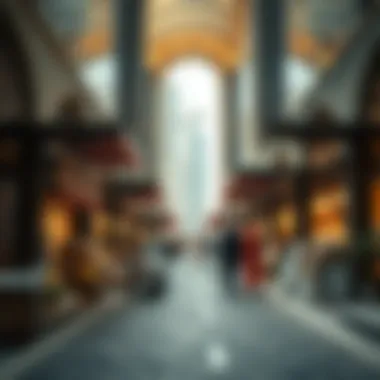
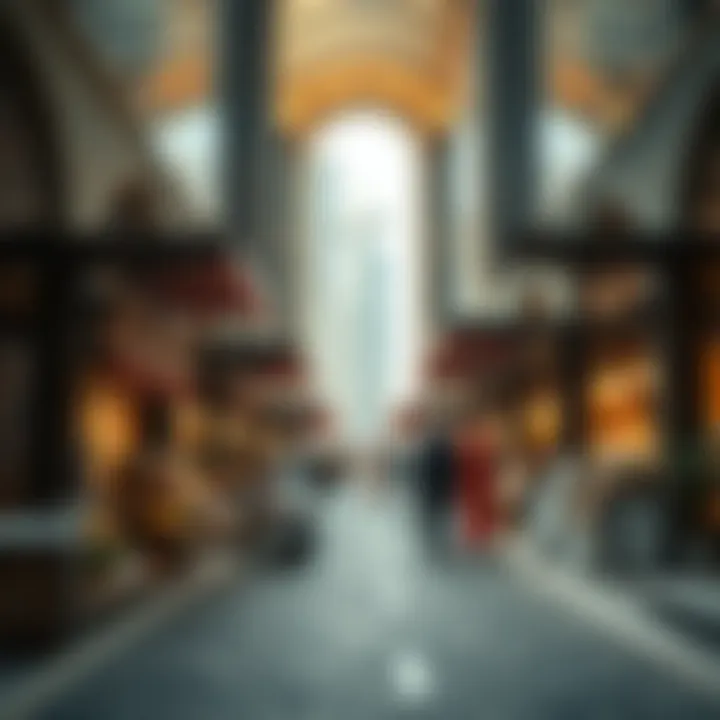
Tourism plays a crucial role in the Old Dubai Market, a place steeped in history and vibrant with life. Attracting millions of visitors every year, this market is not just a shopping destination but a cultural epicenter. The intersection of tradition and modernity can easily be observed as tourists seek to experience the local flavor while enjoying the rich heritage.
One can't overlook how the appeal of the Old Dubai Market roams beyond mere transactions. It serves as a gateway for travelers wanting to immerse themselves in the authentic Emirati experience. Tourists are often drawn to the market not just for its array of goods but for its enchanting atmosphere filled with the scents of spices and the sounds of bargaining. Visitors, whether they come from nearby Gulf states or from the other corner of the globe, are bound to find something that resonates with their sense of adventure and curiosity.
- Local Artisans: The market celebrates local craftsmanship. Visitors can explore shops selling traditional textiles, intricate jewelry, and handmade souvenirs. This allows artisans to showcase their skills and helps tourists appreciate local craftsmanship, creating a bond between visitors and the community.
- Food Experience: Culinary offerings draw foodies to the market, where local street food delights can be found. From aromatic kebabs to sweets like baklava, the market presents a delicious journey through Emirati cuisine.
Understanding the demographics of the visitors is indispensable for stakeholders. Different groups come for varied reasons, and knowing these insights can influence local businesses and tourism strategies. In this section, we will delve into the Visitor Demographics to better grasp who is attracted to this historic market.
Visitor Demographics
The Old Dubai Market draws a diverse crowd. Families often stroll through its narrow alleys, while groups of young adventurers find joy in exploring the nooks and crannies of this bustling area. Data collected over the years indicates that the composition of visitors can be categorized roughly into several segments:
- Local Residents: They frequent the market for everyday shopping and cultural experiences. For many, the market serves as a nostalgic reminder of the past.
- International Tourists: With backgrounds ranging from Middle Eastern countries to European nations and beyond, these visitors typically look for authenticity and memorable experiences. The vibrant atmosphere and engaging vendor interactions captivate many.
- Business Travelers: Often found in search of unique gifts and artisanal products to take back home or showcase their businesses, they play a significant role in the economic fabric of the market.
Understanding these demographics allows entrepreneurs, real estate investors, and marketers to craft tailored strategies that cater to the needs of varied visitors, making the Old Dubai Market more appealing for everyone.
Promotional Strategies
To keep the Old Dubai Market relevant in a rapidly changing landscape, effective promotional strategies must be employed. This includes harnessing modern technology and social media platforms to boost visibility. The following points outline successful methods to promote the Old Dubai Market:
- Social Media Campaigns: Utilizing platforms like Instagram and Facebook to share stunning visuals of the market’s vibrant scenes can ignite interest and compel users to visit. Engagement with influencers can further elevate visibility.
- Cultural Events: Hosting traditional events or festivals showcases the heritage of the area. These events draw tourists and foster a sense of community among local residents.
- Partnerships with Travel Agencies: Collaborating with travel agencies allows package deals that include visits to the market, ensuring a steady flow of tourists seeking an authentic experience.
"The Old Dubai Market stands as a testament not just to commerce but to a way of life that continues to thrive amid the tides of modern development."
Future Developments
The future of the Old Dubai Market is not just about preserving its storied past; it is also about adapting to an ever-evolving urban landscape. Understanding the significance of future developments in this historical market context is crucial. It isn't merely about bricks and mortar; it intrigues how socioeconomic dynamics interlace with cultural heritage and modern aspirations. Future developments can foster an environment that honors history while driving economic growth. For investors, architects, and policymakers alike, there lies a golden opportunity to define what the Old Dubai Market can be in years to come.
Urban Planning Initiatives
Urban planning initiatives surrounding the Old Dubai Market are set to create a fine balance between nostalgia and modernity. These projects aim not only at enhancing the infrastructure but fostering a pedestrian-friendly atmosphere that attracts visitors and locals alike. Some of the key considerations include:
- Revitalization Projects: These include upgrading access routes, improving pedestrian walkways, and ensuring that the area's historical feel is preserved.
- Mixed-Use Developments: Introducing residential spaces combined with commercial opportunities can attract a broader demographic, ensuring that the market stays vibrant and relevant.
- Smart Planning: Integrating technology into the infrastructure can enhance the market experience. This includes positioning information kiosks and utilizing mobile applications to guide tourists.
All these elements are vital for keeping the Old Dubai Market alive and appealing while embracing change. Proper urban planning ensures that future activities are in harmony with the site’s cultural and historical significance.
Sustainability Efforts
As Dubai positions itself as a leader in sustainable urban living, the Old Dubai Market stands to benefit from targeted sustainability efforts. The shift towards eco-friendly practices is integral in maintaining the market's allure for future generations. A few notable sustainability efforts include:
- Eco-Friendly Materials: Using sustainable building materials for renovations can reduce the environmental impact while preserving the aesthetic character of the market.
- Green Spaces: Incorporating parks or rooftop gardens will not only beautify the area but also promote biodiversity and improve air quality.
- Waste Management Systems: Implementing effective waste management practices, like recycling stations, can minimize the environmental footprint of the market.
Through these sustainability initiatives, the Old Dubai Market can be transformed into a beacon of responsible tourism and heritage preservation. Such efforts would not only attract eco-conscious visitors but also inspire local businesses to follow suit.
In summary, the prospects of urban planning and sustainability efforts around the Old Dubai Market represent an exciting era. With the right strategies in place, we can ensure that this vibrant marketplace continues to thrive, delivering economic benefits while retaining its cultural integrity.
"The evolution of the Old Dubai Market is a testament to the ability of heritage to coexist with dynamic urban transformations."
Through thoughtful interventions, this historical center stands to not just adapt but flourish within the broader Dubai landscape, shaping future narratives while telling the tales of its rich past.
Epilogue
The significance of the Old Dubai Market cannot be overstated; it serves as a living testament to the intricate tapestry of cultural, economic, and architectural threads that define Dubai. As we step back and reflect on this bustling hub, it becomes clear how pivotal it has been in shaping the identity of the city. From its humble beginnings thriving on trade routes, this vibrant market has morphed into not just a commercial center but a cultural icon, offering both locals and tourists a window into the rich history of Dubai’s heritage.
Summation of Key Points
- Cultural Importance: The market is not merely a place to buy and sell; it's steeped in history, preserving traditional crafts and practices that have been passed down through generations. Local artisans showcase their trade, connecting the past with the present.
- Economic Significance: Its role in fostering economic activity is undeniable. The Old Dubai Market has provided countless jobs, supporting families and communities. It stirs the local economy, attracting not just buyers but also new business ventures.
- Architectural Value: The design and architecture reflect a blend of historical and modern elements, ensuring that the market remains a pivotal landmark in Dubai’s landscape.
- Tourism Magnet: For tourists, the market offers an immersive experience—shopping for spices, textiles, and traditional souvenirs, while also enjoying local cuisine, which adds layers to the visitor experience.
- Future Intentions: Observing modern demands, planners are ensuring that the market evolves while preserving its essence, paving the way for sustainability efforts that respect both culture and commerce.
Final Thoughts on Preservation
Preservation of the Old Dubai Market goes beyond maintaining its physical structure; it involves safeguarding the stories and traditions that echo within its walls. It is crucial to recognize the fading whispers of the past as modernization sweeps through contemporary Dubai. Investments in urban planning must focus on harmonizing progress with preservation. By fostering initiatives that promote cultural education and ethical tourism, we can sustain not only the market itself but also the vibrant heritage it embodies.
Ultimately, as Dubai continues to rise on the global stage, the Old Dubai Market stands as a crucial reminder of the city’s evolving identity, linking generations through commerce and culture. It’s essential for stakeholders, whether investors or community members, to prioritize its preservation. By doing so, they ensure that this treasure remains not only for today but for future generations to appreciate and cherish.
"Preserving the past is not about holding onto old ways, it's about honoring them as stepping stones towards a vibrant future."
For further reading on Dubai's historical markets, visit Wikipedia and Britannica.
